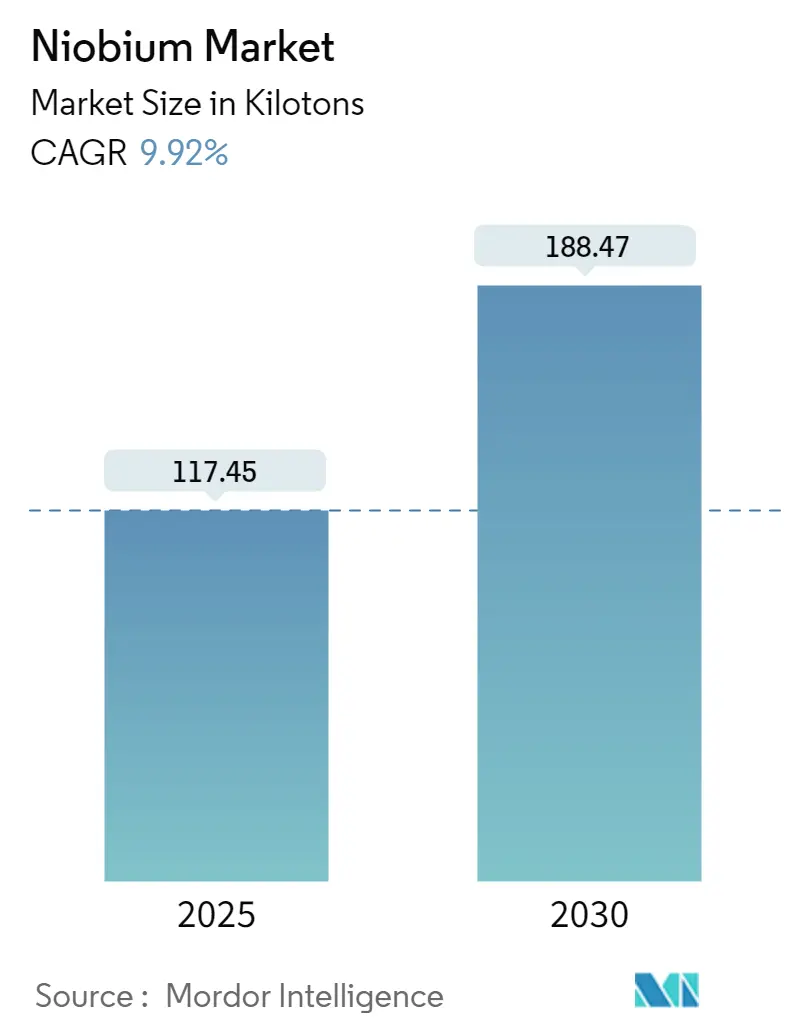
| Study Period | 2019 - 2030 |
| Market Volume (2025) | 117.45 kilotons |
| Market Volume (2030) | 188.47 kilotons |
| CAGR | 9.92 % |
| Fastest Growing Market | Asia Pacific |
| Largest Market | Asia Pacific |
| Market Concentration | High |
Major Players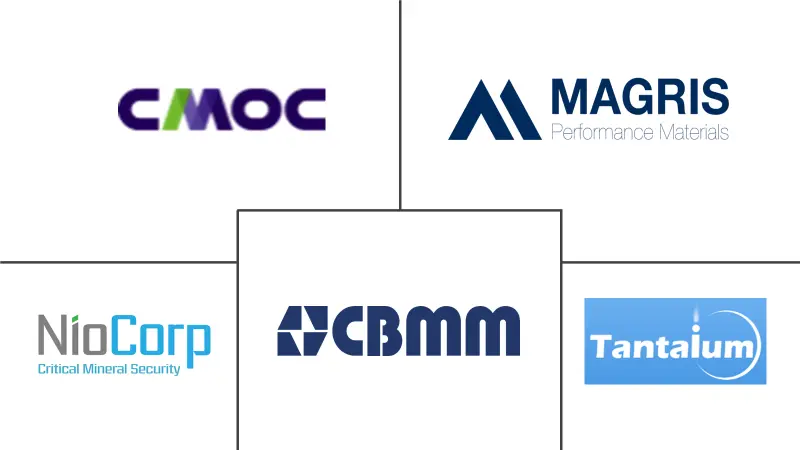
*Disclaimer: Major Players sorted in no particular order |
Niobium Market Analysis
The Niobium Market size is estimated at 117.45 kilotons in 2025, and is expected to reach 188.47 kilotons by 2030, at a CAGR of 9.92% during the forecast period (2025-2030).
The niobium industry is experiencing significant transformation driven by technological advancements and shifting global industrial demands. The steel industry, a major consumer of niobium, witnessed notable changes in 2022-2023, with global steel demand declining by 2.3% in 2022 but showing signs of recovery with an expected 1% growth in 2023, according to the World Steel Association. This fluctuation has prompted steel manufacturers to focus on developing high-performance materials, leading to increased interest in niobium-based solutions for enhanced structural properties and durability.
The electric vehicle (EV) battery sector has emerged as a promising frontier for niobium applications, particularly in next-generation battery technology. In 2022, the demand for automotive Li-ion batteries surged by 65%, reaching 550 GWh, driven by tremendous growth in electric passenger car sales. Major industry players are actively developing niobium-based battery solutions, with companies like CBMM and Toshiba collaborating on research projects to utilize niobium as an alternative to traditional battery materials, focusing on improving charging speeds and overall battery performance.
Infrastructure development and construction activities worldwide are creating new opportunities for niobium applications. According to Oxford Economics, the global construction industry is projected to grow by USD 4.5 trillion between 2020 and 2030, reaching USD 15.2 trillion. This growth is particularly evident in emerging economies, where large-scale infrastructure projects are driving demand for high-strength low-alloy (HSLA) steel, which contains niobium as a crucial component for improving structural integrity and performance.
The industry is witnessing significant technological innovations in mining and processing techniques. In 2023, several key developments have emerged in sustainable mining practices and processing efficiency. For instance, Brazil's CBMM announced plans to invest USD 80 million to increase niobium oxide capacity to 3,000 tonnes by 2024 from the current 500 tonnes, demonstrating the industry's commitment to meeting growing demand through technological advancement. These developments are accompanied by an increasing focus on environmental sustainability, with companies implementing water recycling initiatives and cleaner production processes.
Niobium Market Trends
Accelerating Usage in Structural Steel
The construction industry represents one of the largest consumers of niobium globally, primarily driven by its extensive use in high-strength low alloy (HSLA) steel applications. Niobium-microalloyed steel products are increasingly being utilized in the construction of bridges, viaducts, high-rise buildings, and other critical infrastructure projects due to their superior strength and cost-effectiveness through weight reduction. The material's application extends beyond traditional construction to heavy machinery, pressure vessels, and structural sections used in transmission towers, where niobium effectively competes with alternative materials like vanadium. The construction sector has witnessed substantial investments, with Oxford Economics projecting the global construction industry to expand by USD 4.5 trillion between 2020 and 2030, reaching USD 15.2 trillion.
The growing urbanization trend and increasing focus on infrastructure development have further accelerated the usage of niobium in structural steel applications. For instance, in the United States, the value of new construction output reached USD 1,792.9 billion in December 2022, with the non-residential sector accounting for USD 997.14 billion in March 2023, marking an 18.8% growth compared to the previous year. Similarly, the European construction sector experienced a 2.5% growth in 2022, driven by new investments from the EU Recovery Fund, with non-residential construction projects accounting for 31.3% of total activity. The material's ability to enhance steel's strength while reducing overall weight has made it particularly valuable in large-scale infrastructure projects, where cost efficiency and structural integrity are paramount considerations.
Growing Demand for Lighter-Weight and More Fuel-Efficient Vehicles
The automotive industry's increasing focus on producing lighter and more fuel-efficient vehicles has emerged as a significant driver for niobium demand. The addition of niobium as a micro-alloy enhances the toughness and strength of steel while ensuring that the automobile body structure remains lightweight, directly contributing to improved fuel efficiency and reduced emissions. The material's unique properties make it particularly valuable in the manufacturing process, as the usage of approximately 300 grams of niobium in steel for a mid-size passenger car can reduce the vehicle's weight by approximately 200 kilograms, leading to improved fuel economy of 1 liter per 200 kilometers.
The transition toward electric vehicles (EVs) has further amplified the demand for niobium in the automotive sector. Major automotive manufacturers are increasingly incorporating niobium-containing materials in their vehicle designs, particularly in structural components and battery technology. For instance, China's government has set an ambitious target of achieving a 20% penetration rate for electric vehicle production by 2025, driving increased demand for lightweight materials and advanced battery solutions. The material's application extends beyond traditional vehicle manufacturing to the development of next-generation batteries, where niobium-based materials are being explored as alternatives to conventional battery components, offering potential improvements in charging speed, safety, and overall performance.
Segment Analysis: Occurrence
Carbonatites and Associates Segment in Niobium Market
The Carbonatites and Associates segment dominates the global niobium market, accounting for approximately 95% of the total market share in 2024. This segment's prominence is primarily attributed to the fact that almost all of the world's identified resources of niobium occur as pyrochlore in carbonatite deposits. The largest deposits of pyrochlore are found in Brazil and Canada, with Brazil's Araxá facility using a 15-stage beneficiation and processing operation. Carbonatites are characteristically rich in niobium, which is preferentially enriched over tantalum in carbon dioxide-rich melts. The segment's growth is driven by the increasing demand from steel manufacturers, as niobium from carbonatite deposits is directly converted to ferroniobium or consumed to produce niobium pentoxide. The segment is expected to maintain its dominant position through 2029, supported by the extensive reserves in Brazil and ongoing technological advancements in extraction and processing methods.
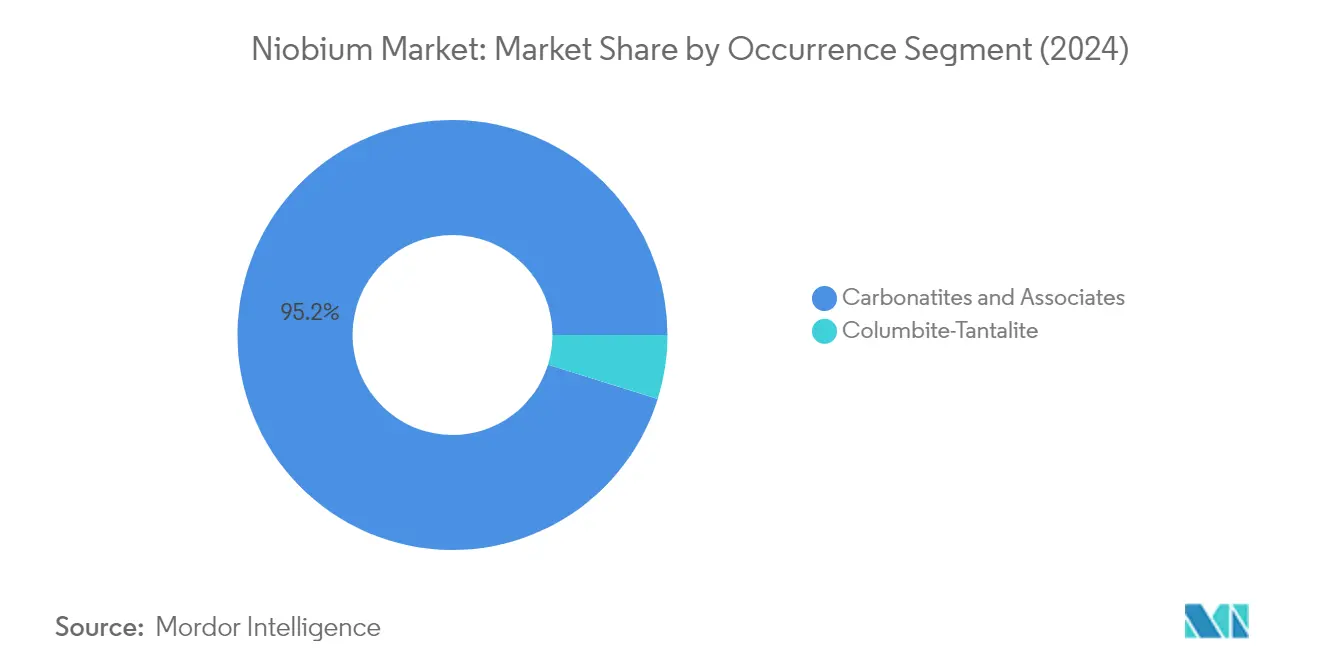
Columbite-Tantalite Segment in Niobium Market
The Columbite-Tantalite segment represents a smaller but significant portion of the niobium market, primarily found in pegmatite intrusions and alkaline intrusive rocks as additional minerals. This segment's market presence is particularly notable in regions like the Democratic Republic of Congo, where small-scale mining operations focus on deeply weathered pegmatites and secondary placer deposits. The segment's importance is underscored by its role in providing an alternative source of niobium, particularly in regions where carbonatite deposits are not present. Countries such as Australia, China, and Nigeria also contribute to niobium production through columbite mining, though at a smaller scale compared to carbonatite sources. The segment maintains its strategic importance in the global niobium supply chain, despite its relatively smaller market share.
Segment Analysis: Type
Ferroniobium Segment in Niobium Market
Ferroniobium dominates the global niobium market, accounting for approximately 88% of the market share in 2024. This significant market position is primarily driven by its extensive use in the steel industry, particularly in the production of high-strength low-alloy (HSLA) steels. The addition of ferroniobium enhances steel's strength and toughness while improving weldability and stability at high temperatures. Its widespread adoption in infrastructure projects, oil and gas pipelines, automotive manufacturing, and construction sectors continues to drive demand. The material's ability to reduce the overall weight of steel structures while maintaining strength has made it particularly valuable in sustainable construction and automotive applications, where a mere 300 grams of ferroniobium can reduce a vehicle's weight by approximately 200 kilograms.
Niobium Oxide Segment in Niobium Market
The niobium oxide segment is experiencing remarkable growth and is projected to expand at approximately 26% during 2024-2029. This exceptional growth is largely attributed to its increasing adoption in next-generation lithium-ion batteries and advanced electronics applications. Major companies like CBMM are investing significantly in expanding their niobium oxide production capacity, with plans to reach 40,000 tonnes by 2030. The material's unique properties, including a high refractive index and electrical characteristics, make it invaluable in optical glass, camera lenses, and electronic components. The segment's growth is further bolstered by its emerging applications in electric vehicle batteries, where it improves charging speed and safety performance.
Remaining Segments in Niobium Type Market
The niobium metal and vacuum-grade niobium alloys segments, while smaller in market share, play crucial roles in specialized applications. Niobium metal is essential in superconducting applications, particularly in medical imaging equipment and particle accelerators, while vacuum-grade niobium alloys are critical in aerospace and high-performance applications. These segments benefit from their unique properties such as high corrosion resistance, superconductivity at low temperatures, and excellent high-temperature performance. The vacuum-grade niobium alloys segment particularly serves niche markets in jet engines, rocket thruster nozzles, and nuclear applications, while niobium metal finds increasing applications in specialized electronic components and medical devices.
Segment Analysis: Application
Steel (HSLA) Segment in Niobium Market
The Steel (HSLA) segment dominates the global niobium market, commanding approximately 89% of the total market share in 2024. This substantial market presence is primarily driven by niobium's crucial role in producing high-strength low-alloy steel, where it significantly enhances steel's strength, mechanical properties, and welding capabilities while improving corrosion resistance. The segment's dominance is further reinforced by the extensive use of niobium-containing HSLA steel in various critical applications, including oil and gas pipelines, automotive bodies, tools, ship hulls, railroad tracks, and numerous specialty applications. The growing emphasis on infrastructure development across major economies and the increasing demand for stronger, lighter materials in construction and transportation sectors continue to fuel the segment's growth.
Batteries Segment in Niobium Market
The Batteries segment is emerging as the fastest-growing application in the niobium market, projected to expand at an impressive rate of approximately 95% during 2024-2029. This exceptional growth is driven by the increasing adoption of niobium in next-generation lithium-ion batteries, particularly in electric vehicle applications. The segment's rapid expansion is supported by ongoing technological advancements and partnerships between major industry players to develop niobium-based battery solutions that offer improved stability, faster charging capabilities, and enhanced safety features. The rising global focus on electric vehicle adoption and sustainable energy storage solutions, coupled with niobium's superior properties in battery applications, continues to drive innovation and investment in this segment.
Remaining Segments in Application Segmentation
The remaining segments in the niobium market include Superalloys, Superconducting Magnets & Capacitors, and Other Applications, each serving distinct industrial needs. The Superalloys segment plays a vital role in aerospace and high-temperature applications, while the Superconducting Magnets & Capacitors segment is crucial for advanced technological applications in medical imaging, scientific research, and particle physics. These segments benefit from niobium's unique properties, including its high corrosion resistance, superconductivity at low temperatures, and ability to enhance material performance in extreme conditions. The Other Applications segment encompasses various specialized uses, including medical devices, electronics, and other emerging applications, contributing to the market's diversification and overall growth potential.
Segment Analysis: End-User Industry
Construction Segment in Niobium Market
The construction sector dominates the global niobium market, accounting for approximately 48% of the total market share in 2024. This significant market position is primarily driven by the extensive use of niobium in high-strength low-alloy (HSLA) steel production, which is crucial for infrastructure development worldwide. The sector's dominance is further reinforced by major infrastructure initiatives across various regions, particularly in Asia-Pacific where countries like China and India are investing heavily in construction projects. According to Oxford Economics, the global construction industry is experiencing substantial growth, with major economies focusing on residential construction, urban development, and infrastructure expansion. The use of niobium-enhanced steel in construction provides superior strength, durability, and cost-effectiveness, making it essential for building bridges, high-rise buildings, and other critical infrastructure projects.
Automotive & Shipbuilding Segment in Niobium Market
The automotive and shipbuilding segment is emerging as the fastest-growing sector in the niobium market, projected to grow at approximately 15% during 2024-2029. This remarkable growth is primarily driven by the increasing demand for lightweight and fuel-efficient vehicles, where niobium plays a crucial role in strengthening steel while reducing overall vehicle weight. The segment's growth is further accelerated by the rapid expansion of electric vehicle production globally, with major automotive manufacturers increasingly incorporating niobium-based materials in their designs. In the shipbuilding sector, the demand is being fueled by the need for stronger, more durable materials in marine applications. The integration of niobium in both automotive and shipbuilding applications is revolutionizing these industries by enabling the production of more efficient, durable, and environmentally friendly vehicles and vessels.
Remaining Segments in End-User Industry
The other significant segments in the niobium market include aerospace and defense, oil and gas, and various other industrial applications. The aerospace and defense sector utilizes niobium in manufacturing critical components for aircraft engines and defense equipment, benefiting from its high-temperature resistance and strength properties. The oil and gas industry relies heavily on niobium-enhanced steel for pipeline construction and offshore drilling platforms, where material durability and corrosion resistance are paramount. Other industrial applications include electronics manufacturing, where niobium is used in capacitors and superconducting materials, and various specialized industrial applications requiring high-performance materials. These segments collectively contribute to the diverse application portfolio of niobium, demonstrating its versatility and importance across multiple industries.
Niobium Market Geography Segment Analysis
Niobium Market in Asia-Pacific
The Asia-Pacific region represents the largest and most dynamic niobium market, driven by robust industrial growth across multiple sectors. China leads the regional consumption, particularly in steel production and emerging electric vehicle battery applications. India's expanding infrastructure and automotive sectors have created substantial demand, while Japan and South Korea maintain steady consumption in their advanced manufacturing and electronics industries. The region's growth is further supported by increasing investments in construction, automotive manufacturing, and technological advancement across various countries.
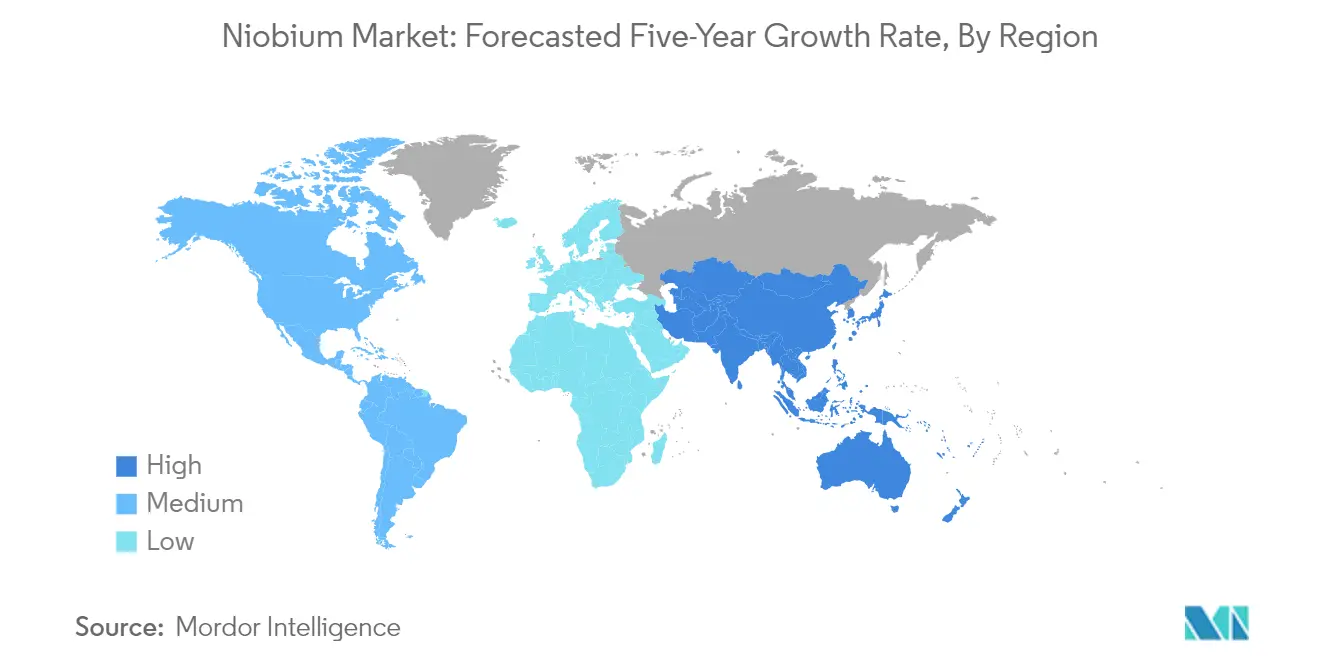
Niobium Market in China
China dominates the Asia-Pacific niobium market, commanding approximately 61% of the regional consumption. The country's dominance is driven by its massive steel industry, which continues to be the world's largest producer and consumer. China's infrastructure construction is accelerating as the government continues to build public confidence in economic growth. The automotive sector, particularly the electric vehicle segment, has emerged as a significant consumer of niobium-based materials. The country's shipbuilding sector has also shown remarkable recovery, with significant investments in new environmentally friendly vessels and advanced marine technologies.
Niobium Market in India
India represents the fastest-growing market in the Asia-Pacific region, with a projected growth rate of around 6% from 2024-2029. The country's rapid industrialization and infrastructure development initiatives, including major construction projects and transportation networks, are driving niobium demand. India's automotive manufacturing sector has shown significant expansion, with increasing adoption of high-strength steel in vehicle production. The country's push toward electric vehicle manufacturing and energy infrastructure development has created new avenues for niobium consumption, particularly in battery technology and specialized steel applications.
Niobium Market in North America
The North American niobium market is characterized by sophisticated end-use applications across aerospace, automotive, and energy sectors. The United States leads the regional consumption, followed by Canada and Mexico. The region's demand is primarily driven by high-performance applications in aerospace, advanced manufacturing, and infrastructure development. The market is further strengthened by increasing investments in electric vehicle production and renewable energy infrastructure across all three countries.
Niobium Market in United States
The United States represents the dominant force in North America's niobium market, accounting for approximately 86% of regional consumption. The country's demand is primarily driven by its advanced manufacturing sector, particularly in aerospace and defense applications. The automotive industry's transition toward electric vehicles and lightweight materials has created new opportunities for niobium consumption. The country's robust construction sector and infrastructure development initiatives continue to support steady demand for niobium-containing steel products.
Niobium Market in Canada
Canada emerges as the fastest-growing market in North America, with an expected growth rate of around 5% from 2024-2029. The country's position is unique as it is one of the world's largest niobium companies outside Brazil. Canada's growth is driven by increasing investments in clean energy infrastructure and advanced manufacturing. The country's automotive sector transformation and significant investments in shipbuilding projects have created sustained demand for niobium-based materials. The government's focus on sustainable development and clean technology has further accelerated niobium consumption in various high-tech applications.
Niobium Market in Europe
The European niobium market demonstrates a strong focus on high-value applications across automotive, aerospace, and industrial sectors. Germany leads the regional consumption, while other major markets include the United Kingdom, Russia, and Italy. The region's transition toward clean energy and electric mobility has created new opportunities for niobium applications. The market is characterized by stringent quality requirements and increasing focus on sustainable production methods.
Niobium Market in Germany
Germany maintains its position as the largest niobium market in Europe, driven by its robust automotive and industrial sectors. The country's leadership in high-end manufacturing and precision engineering creates sustained demand for niobium-based materials. Germany's strong focus on electric vehicle production and renewable energy infrastructure development has opened new avenues for niobium applications. The country's electronics and semiconductor industries also contribute significantly to niobium consumption.
Niobium Market in Italy
Italy represents the fastest-growing market in Europe, driven by its expanding industrial base and technological advancement initiatives. The country's automotive manufacturing sector and growing focus on renewable energy infrastructure have created new opportunities for niobium applications. Italy's steel industry transformation and increasing investments in advanced manufacturing capabilities have supported market growth. The country's focus on quality and innovation in industrial applications continues to drive demand for niobium-based materials.
Niobium Market in South America
The South American niobium market holds strategic importance as the region hosts Brazil, the world's largest niobium companies. Brazil dominates both production and consumption in the region, while Argentina shows promising growth potential. The region's market is characterized by strong integration between mining operations and processing facilities, particularly in Brazil. The automotive sector's growth and infrastructure development initiatives across South American countries continue to drive domestic consumption. The region's rich niobium resources and established processing capabilities position it uniquely in the global supply chain.
Niobium Market in Middle East & Africa
The Middle East & Africa region presents an emerging niobium market for niobium, with growing applications in construction and industrial sectors. Saudi Arabia leads the regional consumption, while South Africa shows the highest growth potential. The region's expanding infrastructure development, particularly in the Gulf countries, drives demand for niobium-containing construction materials. The growing focus on industrial diversification in Middle Eastern countries and the developing manufacturing sector in Africa create new opportunities for niobium applications. The region's energy sector transformation and increasing investments in advanced manufacturing capabilities further support market growth.
Niobium Industry Overview
Top Companies in Niobium Market
The global niobium market is characterized by continuous innovation and strategic developments among key players. Niobium companies are increasingly focusing on expanding their production capacities and developing new applications, particularly in emerging sectors like electric vehicle batteries and advanced materials. Operational excellence is being pursued through vertical integration strategies, with major players controlling everything from mining operations to end-product manufacturing. Strategic partnerships and collaborations, especially in research and development of new niobium-based technologies, have become crucial for maintaining market position. Companies are also emphasizing geographical expansion through distribution networks and regional offices to better serve growing markets, particularly in Asia-Pacific and North America. Environmental sustainability and technological advancement in mining and niobium processing operations have emerged as key focus areas for maintaining competitive advantage.
Oligopolistic Market with High Entry Barriers
The niobium market exhibits a highly concentrated structure with three dominant players controlling nearly all global production. These major companies operate as specialized miners and processors, with significant vertical integration across the value chain. The market's oligopolistic nature is reinforced by the geographical concentration of niobium deposits, primarily in Brazil and Canada, creating natural barriers to entry. The industry has witnessed strategic acquisitions aimed at consolidating market positions, particularly evident in the activities of Chinese companies seeking to secure supply chains. The high capital requirements, technical expertise, and regulatory compliance needed for niobium processing further contribute to maintaining the concentrated market structure.
Recent years have seen increased interest from potential new entrants, particularly in developing alternative sources of niobium production. However, the established players maintain their dominance through superior operational efficiency, established customer relationships, and control over key mining assets. The market's structure is further reinforced by long-term supply agreements with major steel manufacturers and other end-users, creating stable business relationships that are difficult for new entrants to disrupt. Companies have also invested significantly in developing proprietary technologies and processes, creating additional barriers to entry.
Innovation and Sustainability Drive Future Success
For incumbent companies to maintain and expand their niobium market share, focus on technological innovation and sustainable practices has become crucial. Leading firms are investing in research and development to discover new applications for niobium, particularly in emerging sectors like electric vehicles and renewable energy. The development of more efficient extraction and processing methods, combined with environmental stewardship, has become essential for maintaining competitive advantage. Companies are also strengthening their position through strategic partnerships with end-users, particularly in the automotive and construction sectors, while expanding their global presence through enhanced distribution networks.
For contenders seeking to gain ground in the market, specialization in niche applications and focus on underserved geographical regions present opportunities. Success factors include developing innovative processing technologies, establishing strong relationships with end-users, and ensuring reliable supply chains. The increasing focus on environmental regulations and sustainability requirements creates opportunities for companies that can demonstrate superior environmental performance. Additionally, the growing demand for niobium in new applications, particularly in the technology sector, provides potential entry points for new players who can offer specialized products or services. The ability to navigate regulatory requirements while maintaining cost competitiveness will be crucial for both incumbents and new entrants.
Niobium Market Leaders
-
CBMM
-
CMOC
-
Magris Performance Materials
-
NioCorp Development Ltd
-
Changsha South Tantalum Niobium Co.,Ltd.
- *Disclaimer: Major Players sorted in no particular order
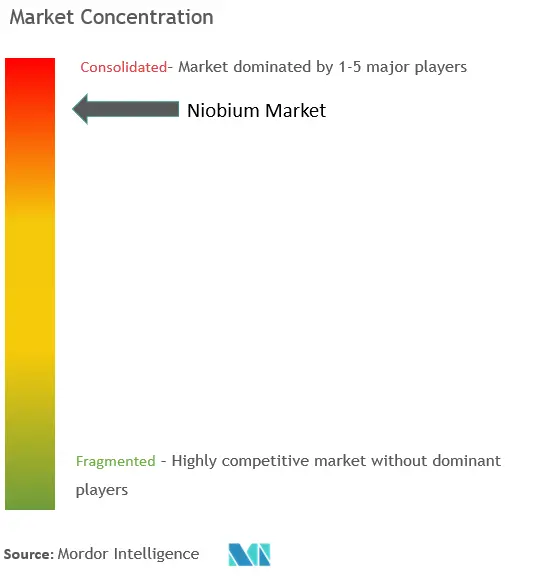
Niobium Market News
- December 2022: CBMM announced a significant investment of USD 80 million to expand its niobium oxide capacity from 500 tons to 3,000 tons by 2024. Collaborating with Echion Technologies, CBMM plans to establish a niobium oxide facility at its Araxá plant in Minas Gerais, Brazil, aligning with its goal of achieving a niobium oxide capacity of 40,000 tons by 2030.
- March 2022: CBMM formed a partnership with Horwin Brasil, a manufacturer of electric motorcycles, with the aim of enhancing access to clean energy and promoting electromobility in the nation. The agreement focused on applying a lithium-ion battery with Niobium in electric two-wheel vehicles. In this partnership, CBMM invested 70 million reais in 2022 and projected sales of 500 tons of niobium oxide. The company's target is to increase niobium product sales to 50,000 tons by 2030.
- January 2022: Kymera International completed the acquisition of Telex Metals, a global supplier of tantalum, tungsten, and niobium particulates. This strategic acquisition will expand Kymera's business into tantalum and niobium materials.
Niobium Market Report - Table of Contents
1. INTRODUCTION
- 1.1 Study Assumptions
- 1.2 Scope of the Study
2. RESEARCH METHODOLOGY
3. EXECUTIVE SUMMARY
4. MARKET DYNAMICS
-
4.1 Drivers
- 4.1.1 Accelerating Usage in Structural Steel
- 4.1.2 Growing Demand for Lighter-Weight and More Fuel-Efficient Vehicles
-
4.2 Restraints
- 4.2.1 Limited Supply Sources
- 4.2.2 Concerns About Health Issues on Acute Exposure
- 4.3 Industry Value Chain Analysis
-
4.4 Porter's Five Forces Analysis
- 4.4.1 Bargaining Power of Suppliers
- 4.4.2 Bargaining Power of Buyers
- 4.4.3 Threat of New Entrants
- 4.4.4 Threat of Substitute Products and Services
- 4.4.5 Degree of Competition
- 4.5 Technological Snapshot/ Production Analysis
- 4.6 Price Trends
5. MARKET SEGMENTATION (Market Size in Volume)
-
5.1 Occurrence
- 5.1.1 Carbonatites and Associates
- 5.1.2 Columbite-Tantalite
-
5.2 Type
- 5.2.1 Ferroniobium
- 5.2.2 Niobium Oxide
- 5.2.3 Niobium Metal
- 5.2.4 Vacuum-Grade Niobium Alloys
-
5.3 Application
- 5.3.1 Steel
- 5.3.2 Super Alloys
- 5.3.3 Superconducting Magnets and Capacitors
- 5.3.4 Batteries
- 5.3.5 Other Applications
-
5.4 End-user Industry
- 5.4.1 Construction
- 5.4.2 Automotive and Shipbuilding
- 5.4.3 Aerospace and Defense
- 5.4.4 Oil and Gas
- 5.4.5 Other End-user Industries
-
5.5 Geography
- 5.5.1 Asia-Pacific
- 5.5.1.1 China
- 5.5.1.2 India
- 5.5.1.3 Japan
- 5.5.1.4 South Korea
- 5.5.1.5 Rest of Asia-Pacific
- 5.5.2 North America
- 5.5.2.1 United States
- 5.5.2.2 Canada
- 5.5.2.3 Mexico
- 5.5.3 Europe
- 5.5.3.1 Germany
- 5.5.3.2 United Kingdom
- 5.5.3.3 Russia
- 5.5.3.4 Italy
- 5.5.3.5 Rest of Europe
- 5.5.4 South America
- 5.5.4.1 Brazil
- 5.5.4.2 Argentina
- 5.5.4.3 Rest of South America
- 5.5.5 Middle-East and Africa
- 5.5.5.1 Saudi Arabia
- 5.5.5.2 South Africa
- 5.5.5.3 Rest of Middle-East and Africa
6. COMPETITIVE LANDSCAPE
- 6.1 Mergers and Acquisitions, Joint Ventures, Collaborations, and Agreements
- 6.2 Market Share (%)**/Ranking Analysis
- 6.3 Strategies Adopted by Leading Players
-
6.4 Company Profiles
- 6.4.1 Admat Inc.
- 6.4.2 Australian Strategic Materials Ltd
- 6.4.3 CBMM
- 6.4.4 Changsha South Tantalum Niobium Co.,Ltd
- 6.4.5 CMOC
- 6.4.6 Grandview Materials
- 6.4.7 Magris Performance Materials
- 6.4.8 NioCorp Development Ltd.
- 6.4.9 Titanex GmbH
- *List Not Exhaustive
7. MARKET OPPORTUNITIES AND FUTURE TRENDS
- 7.1 Expected Usage of Niobium in Next-Generation Lithium Ion Battery
- 7.2 Innovative Techniques and Mine Designing
Niobium Industry Segmentation
Niobium is a rare, soft, malleable, ductile, gray-white metal. Niobium is primarily used in alloys, including stainless steel. It improves the strength of the alloys, particularly at low temperatures. At present, it is gaining momentum in lithium-ion battery production.
The niobium market is segmented based on occurrence, type, application, end-user industry, and geography. By occurrence, the market is segmented into carbonatites and associates and columbite-tantalite. By type, the market is segmented into ferroniobium, niobium oxide, niobium metal, and vacuum grade niobium alloys. By application, the market is segmented by steel, superalloys, superconducting magnets and capacitors, batteries, and other applications. By end-user industry, the market is segmented by construction, automotive and shipbuilding, aerospace and defense, oil and gas, and other end-user industries. The report offers market size and forecasts for 15 countries across major regions. For each segment, market sizing and forecasts have been done on the basis of volume (tons) for all the above segments.
| Occurrence | Carbonatites and Associates | ||
| Columbite-Tantalite | |||
| Type | Ferroniobium | ||
| Niobium Oxide | |||
| Niobium Metal | |||
| Vacuum-Grade Niobium Alloys | |||
| Application | Steel | ||
| Super Alloys | |||
| Superconducting Magnets and Capacitors | |||
| Batteries | |||
| Other Applications | |||
| End-user Industry | Construction | ||
| Automotive and Shipbuilding | |||
| Aerospace and Defense | |||
| Oil and Gas | |||
| Other End-user Industries | |||
| Geography | Asia-Pacific | China | |
| India | |||
| Japan | |||
| South Korea | |||
| Rest of Asia-Pacific | |||
| North America | United States | ||
| Canada | |||
| Mexico | |||
| Europe | Germany | ||
| United Kingdom | |||
| Russia | |||
| Italy | |||
| Rest of Europe | |||
| South America | Brazil | ||
| Argentina | |||
| Rest of South America | |||
| Middle-East and Africa | Saudi Arabia | ||
| South Africa | |||
| Rest of Middle-East and Africa | |||
Niobium Market Research FAQs
How big is the Niobium Market?
The Niobium Market size is expected to reach 117.45 kilotons in 2025 and grow at a CAGR of 9.92% to reach 188.47 kilotons by 2030.
What is the current Niobium Market size?
In 2025, the Niobium Market size is expected to reach 117.45 kilotons.
Who are the key players in Niobium Market?
CBMM, CMOC, Magris Performance Materials, NioCorp Development Ltd and Changsha South Tantalum Niobium Co.,Ltd. are the major companies operating in the Niobium Market.
Which is the fastest growing region in Niobium Market?
Asia Pacific is estimated to grow at the highest CAGR over the forecast period (2025-2030).
Which region has the biggest share in Niobium Market?
In 2025, the Asia Pacific accounts for the largest market share in Niobium Market.
What years does this Niobium Market cover, and what was the market size in 2024?
In 2024, the Niobium Market size was estimated at 105.80 kilotons. The report covers the Niobium Market historical market size for years: 2019, 2020, 2021, 2022, 2023 and 2024. The report also forecasts the Niobium Market size for years: 2025, 2026, 2027, 2028, 2029 and 2030.
Our Best Selling Reports
Niobium Market Research
Mordor Intelligence provides a comprehensive analysis of the niobium market, also known as the columbium industry. We leverage our extensive expertise in transition metals research. Our detailed report examines the complete value chain, from niobium processing to end-use applications. This includes microalloyed steel production and refractory metals applications. The analysis covers various forms, such as niobium oxide, niobium carbide, niobium pentoxide, and ferroniobium. These insights are crucial for stakeholders in the vital transition metals market.
Our in-depth research benefits niobium companies by offering a detailed analysis of NB industry dynamics. This includes the latest developments in niobium alloy manufacturing and niobium superconductor technologies. The report examines various niobium compounds and their applications across industries. It is available in an easy-to-download report PDF format. Stakeholders gain valuable insights into refractory metals market trends, supported by comprehensive data on niobium metal applications and emerging opportunities in the global marketplace.




